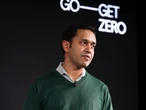The climate crisis is worsening. Last year was the warmest on record, global sea ice levels are at a record low, and the economic toll of extreme natural disasters continues to mount.
Just this week, the World Meteorological Organization said the global average temperature is likely to rise nearly 2 degrees Celsius above pre-industrial levels within the next five years, with “growing negative impact on our economies, our daily lives, our ecosystems and our planet.” Experts are adamant that the only way to slow the warming is to stop burning the fossil fuels that create the greenhouse effect.
And yet, in 2024, emissions reached a new high. As the WMO’s Secretary-General Celeste Saulo put it: “We are heading in the wrong direction.” And as the temperature rises, so does the chance that Earth’s natural systems will cross thresholds that trigger irreversible and cascading destruction.
The encroaching threat of these tipping points is why the British government’s Advanced Research and Invention Agency (ARIA) is pouring £57 million ($76 million) into studying “climate cooling approaches.” That’s a fancy way of referring to climate geoengineering, or intentionally tinkering with the Earth’s weather systems in an attempt to cool things down. More specifically, ARIA is examining whether we might be able to reflect some sunlight away from the surface of the Earth and back into space.
With this investment, the UK government becomes the top funder of solar geoengineering research in the world. But what’s really raising eyebrows is the news that some of ARIA’s experiments could take place outside, in the real world, and with a government’s seal of approval. Could this be a step toward legitimizing what has, up until now, been seen as a climate hack of last resort?
Geoengineering has long been a somewhat taboo topic in the larger conversation about climate change. Many scientists worry it could have unintended and irreversible consequences, possibly doing more harm than good. For example, modelling from a recent study published in the journal Nature Climate Change suggested that so-called marine cloud brightening off the U.S. West Coast would indeed help lower temperatures locally, but could inadvertently trigger more intense heat waves in Europe.
At the same time, environmentalists fear geoengineering would give a free pass to polluters to carry on with business as usual. ARIA acknowledges these anxieties, and gives concession to the net-zero purists. Decarbonization “is the only sustainable way to reduce global temperatures,” says ARIA program director Mark Symes.
But ARIA also says that the “dearth of real and relevant physical data from outdoor [geoengineering] experiments” is itself dangerous given the direction we’re headed. “What might be the risks of hurried deployment of under-researched climate engineering approaches where we have little understanding of the consequences?” the group asks. In other words, if things get so bad that we have to use these tools, we’d better know what we’re doing. As things stand, “if we were to face a climate tipping point in the near future, we currently lack the basic knowledge needed to understand what our options are,” Symes says.
ARIA aims to fill the existing knowledge gaps and answer fundamental questions about whether solar geoengineering is practical, measurable, and controllable.
ARIA aims to fill the existing knowledge gaps and answer fundamental questions about whether solar geoengineering is practical, measurable, safe, controllable, or even “whether [it] should be ruled out entirely,” Symes says.
It will fund 21 projects over the next five years, four of which are “controlled, small-scale” outdoor experiments focusing on solar geoengineering methods including: spraying seawater into the air to brighten clouds over the Great Barrier Reef in Australia, and in the UK; using an electric charge to brighten clouds in the UK; and using weather balloons to expose small amounts (as in milligrams) of mineral dust to the stratosphere to understand whether this method could be used to reflect sunlight (the balloon launch locations have yet to be determined but are likely to be in the U.S. or the UK).
A fifth outdoor experiment will focus on trying to re-thicken Arctic sea ice in Canada (which, if successful, could also have the knock-on effect of reflecting more sunlight back into space). The soonest any of these outdoor projects would begin is early 2026.
The other 16 projects will examine the ethics of geoengineering, how it might be responsibly governed, as well as computer modeling and simulating climate cooling in the lab. “ARIA’s broad program of research will help advance our fundamental understanding of solar geoengineering and help to ensure that policymakers have the information they need to make informed decisions about these ideas in future,” said Dr. Pete Irvine, a research assistant professor at the University of Chicago who studies solar geoengineering, and the co-founder of SRM360, a nonprofit focused on fostering discussions around solar reflection methods.
Previous attempts to conduct outdoor geoengineering tests have been short-lived and quickly condemned. At least eight U.S. states have passed or are considering legislation to ban the practice, and the Environmental Protection Agency is investigating a geoengineering startup called Make Sunsets, accusing it of polluting the air (nevermind the EPA’s loosening of pollution restrictions for, say, coal-fired power plants). On an international scale, many nations have signed onto a de facto large-scale geoengineering moratorium. The U.S. has also been building an alert system that would be able to detect if other nations are using solar geoengineering.
None of this has stopped scientists and private companies from dabbling. If anything, the stigma around geoengineering has pushed projects to become more rogue and secretive. Just last year, a study on cloud brightening techniques in Alameda, California, was forced to shut down in part because local officials only learned about the research from an article in The New York Times.
The ARIA program is hoping to avoid a similar fate by engaging with local communities at the outset of a project, and keeping lines of communication open as work progresses. “ARIA sees consultation and engagement with the public as processes that will be sustained for the lifetime of projects,” Symes wrote recently. “A key aim is to earn and maintain trust in the research that is being undertaken.” The group will conduct environmental assessments, and be transparent about any known risks, as well as test results. The program is also overseen by an independent oversight committee.
ARIA says it has no intention of actually deploying or scaling any of the solutions it wants to test. That may be a comfort to some, but it could also be seen to undermine the value and legitimacy of the research. “These technologies will always remain speculative, and unproven in the real world, until they are deployed at scale,” said Mike Hulme, a professor of human geography at the University of Cambridge. “Just because they ‘work’ in a model, or at a micro-scale in the lab or the sky, does not mean they will cool the climate safely, without unwanted side-effects, in the real world. There is therefore no way that this research can demonstrate that the technologies are safe, successful, or reversible.”
There’s no real guarantee these experiments will go ahead. According to ARIA documents, the tests will be required to start indoors, and can only move out of the lab if questions still remain unanswered and researchers are certain that any effects would last no longer than 24 hours. And ARIA might pull the plug on a project that fails to meet certain research milestones.
“Our current trajectory suggests that warming is happening at an alarming rate,” Symes says. “Our goal is to build knowledge and help shape global standards for how this science is conducted responsibly.”









No comments